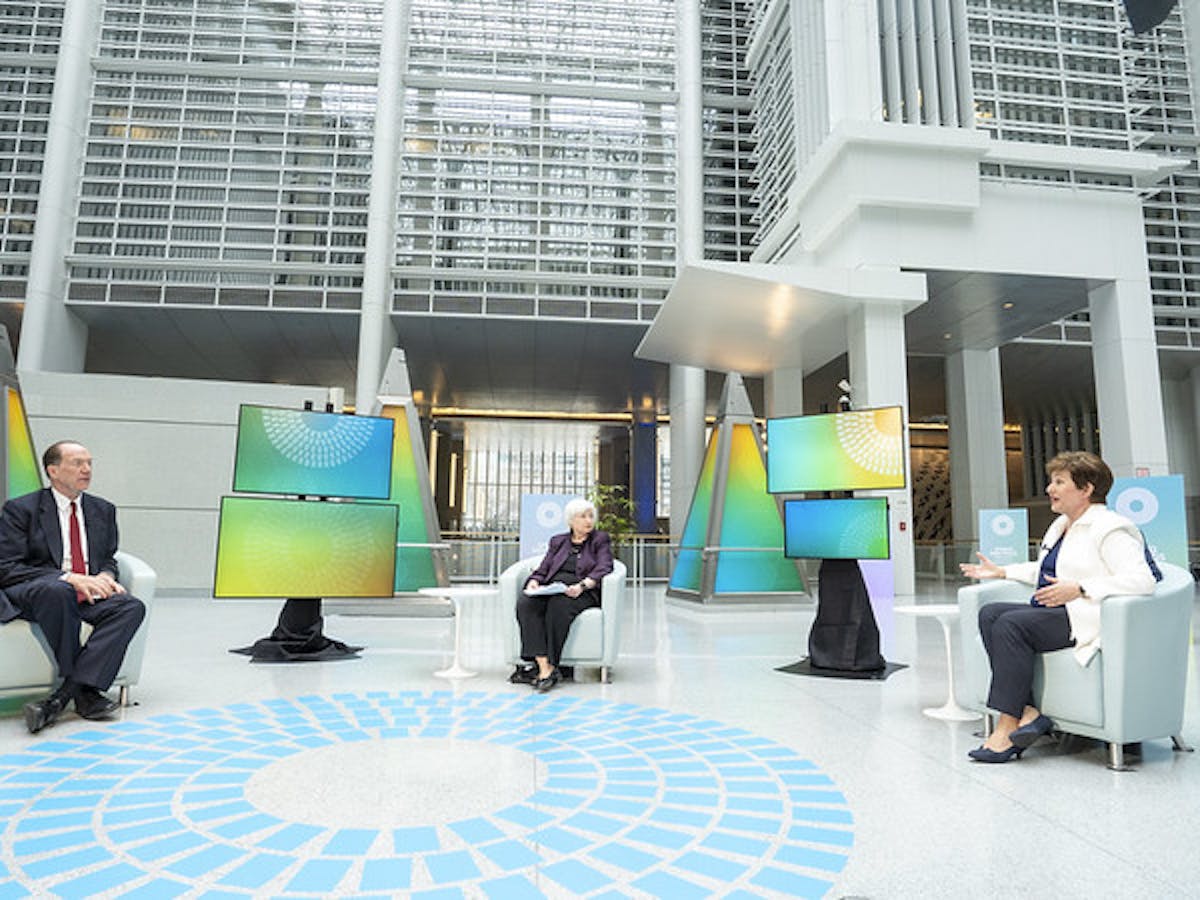In 2020, the global economy took a major hit with the onset of the COVID-19 pandemic, causing global GDP to fall by 3.3 percent. But that is expected to reverse course, with the global economy projected to grow 6 percent by the end of 2021—growth that reflects additional fiscal support in several large economies and the anticipated vaccine-powered recovery.
While promising, a high level of uncertainty surrounds these new projections—as reported in the International Monetary Fund’s April 2021 World Economic Outlook—and could ending up costing the world economy $9 billion if countries fail to globally distribute vaccinations and get the virus under control. These projections were one of the main topics of discussion at the virtual Spring Meetings of the IMF and World Bank Group, where the institutions met to discuss their progress on the COVID-19 pandemic response and economic recovery—and the urgent needs that still must be addressed.
As some of the World Bank’s more affluent members, the United States and other advanced economies are well positioned to help others on the path toward economic recovery, according to U.S. Secretary of the Treasury Janet Yellen. At the meetings, she emphasized, “It’s the responsibility of the developed countries to make sure that decades of progress in fighting poverty globally and trying to close income gaps between rich and poor countries—we need to see that that progress is not reversed because of the pandemic.”
After the weeklong meetings, here are several takeaways on how the World Bank Group, the IMF, and their member countries are investing to combat COVID-19 around the world.
LARGE-SCALE COORDINATION TO ADDRESS COVID-19 IMPACTS
The World Bank is providing $160 billion in financing – the largest response in the Bank’s history – to help 100 developing countries respond to the health, economic, and social impacts of COVID-19, including $50 billion in resources and $12 billion for vaccine purchase and distribution.
Of the 100 countries supported, 39 are in Sub-Saharan Africa and nearly one-third of the total projects are in fragile and conflict-affected situations—many of which have experienced knock-on effects from the pandemic that have made these situations even more precarious and sometimes volatile. Violence associated with extremist groups jumped up 43 percent in 2020 compared with 2019.
“In this crisis, central banks and financial authorities have stepped up swiftly in a coordinated manner. We just calculated that if that didn’t happen on this scale, and that degree of coordination, the recession would have been three times deeper,” said Kristalina Georgieva, IMF’s Managing Director.
NEW FINANCING TO COMBAT COVID-19
The World Bank is continuing to identify new opportunities to assist with the pandemic response and economic recovery—and has already had success in countries like India and Kenya. In early April, the World Bank announced $150 million in financing to help Ecuador purchase and distribute vaccines, which will enable to country to vaccinate 30% of its population. Ecuador has seen an 8% increase in its poverty rate since the beginning of the pandemic.
In Kenya, the World Bank is leveraging digital technologies through ongoing partnerships with 15 AgTech startups to transform the delivery of inputs, soil testing, crop insurance, credit, extension advice, and market linkages, to enable farmers to overcome temporary COVID-related constraints and ensure more targeted and effective service delivery, especially in remote areas in the long run.
In India, women’s self-help groups—supported under the National Rural Livelihoods Mission and co-financed by the World Bank—have come together to help their communities respond and recover from the COVID-19 pandemic. Started 15 years ago, these groups include about 62 million women across India who’ve used their skills to help prevent shortages in masks and sanitizer, run community kitchens and restore fresh food supplies, provide food and support to vulnerable and high-risk families, provide financial services in rural areas, and disseminate COVID-19 advisories among rural communities.
FOREIGN AID FROM OFFICIAL DONORS REACH ALL-TIME HIGH
Growing by $10 billion from 2019 to 2020, OECD Development Assistance Committee (DAC) members hit a 30-year high of $161.2 billion in total official development assistance (ODA) funding in response to the COVID-19 pandemic.
Driven by an inclusive global recovery, the United States continued to be the largest contributor to development assistance with $35.5 billion in 2020, followed by Germany (USD 28.4 billion), the United Kingdom (USD 18.6 billion), Japan (USD 16.3 billion) and France (USD 14.1 billion). Due to increased contributions to multilateral organizations, the U.S. constitutes 22% of the total DAC contribution and showed a $1.6 billion increase from 2019.
Initial estimates indicate that DAC countries spent USD 12 billion on COVID-19 related activities, yet the global vaccine distribution facility COVAX remains severely underfunded. OECD Secretary-General Angel Gurría said, “This crisis is a major test for multilateralism and for the very concept of foreign aid. We need to make a much greater effort to help developing countries with vaccine distribution, with hospital services and to support the world’s most vulnerable people’s incomes and livelihoods to build a truly global recovery.”
As we look toward the future, it is important to recognize the power of international cooperation through multilateral partnerships like the IMF and World Bank—and the significant role and influence of the United States has in each of them—in combatting the COVID crisis and its knock-on effects and moving toward greater economic recovery.
Photo: World Bank / Heather Elliott

